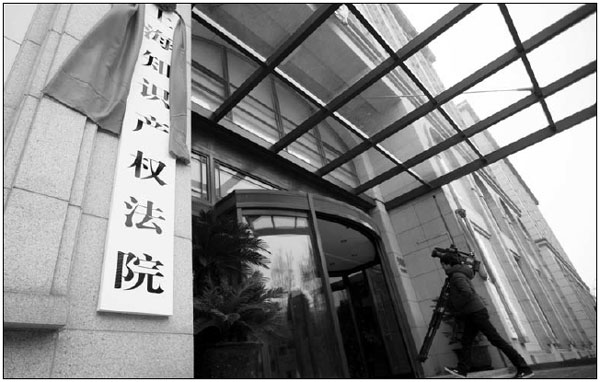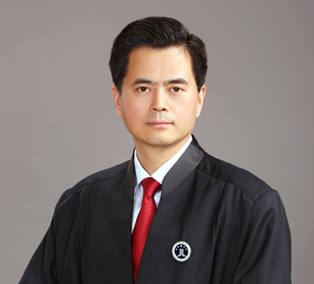IP court cases to come under tighter jurisdiction
font-size:
The "three-in-one" mode for intellectual property cases that integrates civil, administrative and criminal trials will be further promoted in courts nationwide, according to a conference held on July 7 in Nanjing, Jiangsu province.
The two-day event, which attracted nearly 200 IP judges from across the country, called for Chinese courts to give full play to judicial protection of IP rights to provide strong judicial guarantees and services for the development of a powerful IP nation.
The Supreme People's Court issued its opinions on the promotion of such a combined IP trial mechanism just two days before the conference.
IP disputes scattered across civil, administrative and criminal divisions have led to increased difficulties in hearing procedures, as judges in different divisions may see cases differently.
Tao Kaiyuan, vice-president of the Supreme People's Court, said the "three-in-one" mode is an important measure to reform the central judicial system and improve the overall efficiency of judicial protection in the IP field.
She said the nation's courts at all levels will have dedicated IP divisions by integrating the divisions that handle IP cases, except for the IP courts in Beijing, Shanghai and Guangzhou. Provincial courts across the nation will release specific plans by the end of the year.
The senior official of the top court also called for the implementation of a pilot project of the Beijing IP court, which focuses on the cross-regional jurisdiction of technological disputes that covers Beijing, Tianjin and Hebei.
The concept of having local courts dedicated to IP issues was first raised in the 1990s.
The initial move to explore the "three-in-one" trial mode was made by the IP division of the Shanghai Pudong New Area People's Court. It has dealt with nearly 10,000 IP civil, administrative and criminal cases during the past two decades, and has accumulated ample experience that can be studied by other courts.
The mode has since been adopted in six provincial-level courts and nearly 200 intermediate and lower-level courts. They have innovated different trial mechanisms based on regional characteristics.
In Fujian, for example, Xiamen's Siming district court focuses on developing a diverse dispute settlement mechanism. Together with the city's IP office and law enforcement agencies, it has set up a service outlet at a local software park to provide one-stop IP services for high-tech companies.
The provincial court and the provincial IP office of Zhejiang last year jointly established one of China's first civil mediation and litigation centers that allows third-party agencies to join in.
The center is in Yiwu, the world's largest wholesale market for small consumer goods.
Since 2014, the nation's courts have highlighted judicial instruction and protection to improve the quality and effectiveness of IP trials.
Statistics from the People's Court Daily showed that the courts received 130,000 civil, administrative and criminal IP cases of the first instance in 2015, up 11.7 percent year-on-year. The number of concluded cases also increased compared with 2014, without any increase in the number of judges.
At the conference, Tao also said financial compensation for damages will be increased as trials should accurately reflect the market value of infringed IP rights.
For repeated and intentional IP violators, financial compensation can be higher than the market value of the IP rights involved, she added.
The two-day event, which attracted nearly 200 IP judges from across the country, called for Chinese courts to give full play to judicial protection of IP rights to provide strong judicial guarantees and services for the development of a powerful IP nation.
The Supreme People's Court issued its opinions on the promotion of such a combined IP trial mechanism just two days before the conference.
IP disputes scattered across civil, administrative and criminal divisions have led to increased difficulties in hearing procedures, as judges in different divisions may see cases differently.
Tao Kaiyuan, vice-president of the Supreme People's Court, said the "three-in-one" mode is an important measure to reform the central judicial system and improve the overall efficiency of judicial protection in the IP field.
She said the nation's courts at all levels will have dedicated IP divisions by integrating the divisions that handle IP cases, except for the IP courts in Beijing, Shanghai and Guangzhou. Provincial courts across the nation will release specific plans by the end of the year.
The senior official of the top court also called for the implementation of a pilot project of the Beijing IP court, which focuses on the cross-regional jurisdiction of technological disputes that covers Beijing, Tianjin and Hebei.
The concept of having local courts dedicated to IP issues was first raised in the 1990s.
The initial move to explore the "three-in-one" trial mode was made by the IP division of the Shanghai Pudong New Area People's Court. It has dealt with nearly 10,000 IP civil, administrative and criminal cases during the past two decades, and has accumulated ample experience that can be studied by other courts.
The mode has since been adopted in six provincial-level courts and nearly 200 intermediate and lower-level courts. They have innovated different trial mechanisms based on regional characteristics.
In Fujian, for example, Xiamen's Siming district court focuses on developing a diverse dispute settlement mechanism. Together with the city's IP office and law enforcement agencies, it has set up a service outlet at a local software park to provide one-stop IP services for high-tech companies.
The provincial court and the provincial IP office of Zhejiang last year jointly established one of China's first civil mediation and litigation centers that allows third-party agencies to join in.
The center is in Yiwu, the world's largest wholesale market for small consumer goods.
Since 2014, the nation's courts have highlighted judicial instruction and protection to improve the quality and effectiveness of IP trials.
Statistics from the People's Court Daily showed that the courts received 130,000 civil, administrative and criminal IP cases of the first instance in 2015, up 11.7 percent year-on-year. The number of concluded cases also increased compared with 2014, without any increase in the number of judges.
At the conference, Tao also said financial compensation for damages will be increased as trials should accurately reflect the market value of infringed IP rights.
For repeated and intentional IP violators, financial compensation can be higher than the market value of the IP rights involved, she added.

-
Previous:
-
Next:
Related articles
This article has no related articles!






